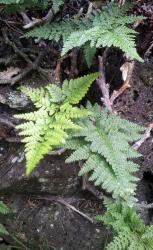Epiphytic, rupestral or terrestrial ferns. Rhizomes long-creeping, scaly, bearing short phyllopodia. Fronds monomorphic (NZ) or dimorphic (not NZ), articulated to the phyllopodia. Laminae 3-pinnate to 4-pinnate-pinnatifid (NZ) or also pinnatifid to 2-pinnate-pinnatifid (not NZ), anadromous, coriaceous, often glabrous but occasionally scaly (NZ) or hairy (not NZ). Veins free, terminating inside the lamina margin; false veins sometimes present between true veins. Sori oblong or obovate (NZ) or round or reniform (not NZ), borne on abaxial surface, submarginal or away from margin; paraphyses absent; indusia attached at base and at least part of the sides, pouched (NZ) to lunate (not NZ); sporangial maturation mixed. Sporangia with vertical annulus, usually 64 spores per sporangium. Homosporous; spores monolete, lacking chlorophyll; perispores verrucate, tuberculate or rugose.
A medium-sized family of one genus and c. 65 species (PPG 1 2016).
The family Davalliaceae has been variously interpreted over time. Copeland (1947) recognised 12 genera, including Oleandra, Nephrolepis, and Arthropteris, a classification that was followed by Allan (1961). However, Pichi Sermolli (1977) separated the latter genera into Oleandraceae and Nephrolepidaceae, respectively, although Arthropteris is now treated in Tectariaceae (PPG 1 2016). Of Copeland’s original genera, Leucostegia is now treated in Hypodematiaceae and Psammiosorus belongs with Arthropteris in Tectariaceae (PPG 1 2016).
The remainder of Davalliaceae was revised by Kato & Tsutsumi (2008), who recognised five genera: Araiostegiella, Davallia, Davallodes, Humata and Wibelia. However, because the type of Davallia had not been analysed at that time, Christenhusz et al. (2011) advocated the recognition of only two genera, Davallia and Davallodes. On the basis of chloroplast and nuclear markers in 41 species, Tsutsumi et al. (2016) argued that the clades in the family are not well distinguished morphologically and they therefore recognised a single genus, Davallia, with seven sections. This was adopted by PPG 1 (2016) and the family treated as sister to Polypodiaceae based on analysis by Schuettpelz & Pryer (2007).
The family Davalliaceae comprises terrestrial or epiphytic species with thick, long-creeping rhizomes densely covered in scales, monomorphic or dimorphic fronds that are articulated to phyllopodia, often deltoid-shaped coriaceous laminae, and submarginal sori protected by lunate to pouched indusia (see Nooteboom 1994, plates 1–4).
A family largely confined to tropical and subtropical regions of the Old World and Pacific, but with a few species extending north to temperate areas of south-west Europe, China, and Japan, and south to New Zealand and Kerguelen (Nooteboom 1994). The centre of diversity is in the Malesian region, but with significant numbers also in China and the Pacific.
| Category | Number |
|---|---|
| Indigenous (Endemic) | 1 |
| Exotic: Fully Naturalised | 1 |
| Exotic: Casual | 1 |
| Total | 3 |




